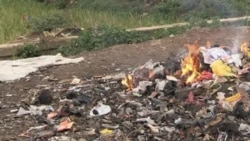GENEVA —
A new report has found that the health of up to 200 million people worldwide is threatened by pollution. Two independent environmental organizations -- Green Cross Switzerland and the U.S.-based Blacksmith Institute -- have just published a list of 10 of the world’s most dangerously polluted places.
The top 10 most polluted places are spread over eight countries located in Africa, Asia, Eastern Europe, and Latin America. They are cited for threatening the lives of the millions of people who live there by exposing them to dangerous environmental toxins.
The report noted that polluants in these places affect people through direct inhalation, food intake and skin contact. Poisonous substances include lead, cadmium, chrome, oil, pesticides, phenols, mercury, sarin, radionuclides and volatile organic compounds.
Agbogbloshie, Ghana
Chernobyl, Ukraine
Citarum River, Indonesia
Dzershinsk, Russia
Hazaribagh, Bangladesh
Kabwe, Zambia
Kalimantan, Indonesia
Matanza Riachuelo, Argentina
Niger River Delta, Nigeria
Norilsk, Russia
Source: Blacksmith Institute/Green Cross Switzerland
The senior technical adviser with the Blacksmith Institute, David Hanrahan, told VOA that four of the sites that were on the first list published in 2006 remain on this year’s list of the world’s most polluted.
“We have Chernobyl -- which is not going to go away, obviously -- in the Ukraine. We have two sites in Russia, of which one is a huge smelter, the other is a major chemical complex, which we think used to do a lot of chemical weapons. We have the mining site in Zambia, [on] which I said work has been done to improve. But, unfortunately, it is an extremely poor, abandoned place,” said Hanrahan.
The other sites are in Argentina, Bangladesh, Ghana, two places in Indonesia and Nigeria’s Niger River Delta.
Despite the ever-present dangers posed by environmental toxins, Hanrahan said progress is being made in cleaning up some of the world’s polluted hot spots.
For example, he points out that the Dominican Republic was on the original top-10 list because of the high levels of lead at a recycling site. He says the country was dropped from the list after cleaning up the site and turning it into a playground.
Similar success stories took place in other places -- including cities in China, which have reduced air pollution, in India and in eastern Russia.
Hanrahan says that in the past, the link between health and the environment tended to be underestimated. However, today public health authorities in many countries recognize the need to address these problems.
“It is causing problems that are really of the similar order as the big international public health concerns like tuberculosis and malaria, HIV/AIDS. Toxic pollution is, in many countries, [on] the same order of magnitude and that is being recognized, which is one of the things that we really are quite pleased about,” said Hanrahan.
Hanrahan also said that more and more governments are seeing environmental pollution as a problem that can be tackled and overcome. He says developing countries that are dealing with these concerns are seeing significant improvements in the health of their people, especially among children, who are most at risk of getting ill or dying.
The top 10 most polluted places are spread over eight countries located in Africa, Asia, Eastern Europe, and Latin America. They are cited for threatening the lives of the millions of people who live there by exposing them to dangerous environmental toxins.
The report noted that polluants in these places affect people through direct inhalation, food intake and skin contact. Poisonous substances include lead, cadmium, chrome, oil, pesticides, phenols, mercury, sarin, radionuclides and volatile organic compounds.
The World's Worst Polluted Places in 2013 (unranked)
The World's Worst Polluted Places in 2013 (unranked)Agbogbloshie, Ghana
Chernobyl, Ukraine
Citarum River, Indonesia
Dzershinsk, Russia
Hazaribagh, Bangladesh
Kabwe, Zambia
Kalimantan, Indonesia
Matanza Riachuelo, Argentina
Niger River Delta, Nigeria
Norilsk, Russia
Source: Blacksmith Institute/Green Cross Switzerland
“We have Chernobyl -- which is not going to go away, obviously -- in the Ukraine. We have two sites in Russia, of which one is a huge smelter, the other is a major chemical complex, which we think used to do a lot of chemical weapons. We have the mining site in Zambia, [on] which I said work has been done to improve. But, unfortunately, it is an extremely poor, abandoned place,” said Hanrahan.
The other sites are in Argentina, Bangladesh, Ghana, two places in Indonesia and Nigeria’s Niger River Delta.
Despite the ever-present dangers posed by environmental toxins, Hanrahan said progress is being made in cleaning up some of the world’s polluted hot spots.
For example, he points out that the Dominican Republic was on the original top-10 list because of the high levels of lead at a recycling site. He says the country was dropped from the list after cleaning up the site and turning it into a playground.
Similar success stories took place in other places -- including cities in China, which have reduced air pollution, in India and in eastern Russia.
Hanrahan says that in the past, the link between health and the environment tended to be underestimated. However, today public health authorities in many countries recognize the need to address these problems.
“It is causing problems that are really of the similar order as the big international public health concerns like tuberculosis and malaria, HIV/AIDS. Toxic pollution is, in many countries, [on] the same order of magnitude and that is being recognized, which is one of the things that we really are quite pleased about,” said Hanrahan.
Hanrahan also said that more and more governments are seeing environmental pollution as a problem that can be tackled and overcome. He says developing countries that are dealing with these concerns are seeing significant improvements in the health of their people, especially among children, who are most at risk of getting ill or dying.










